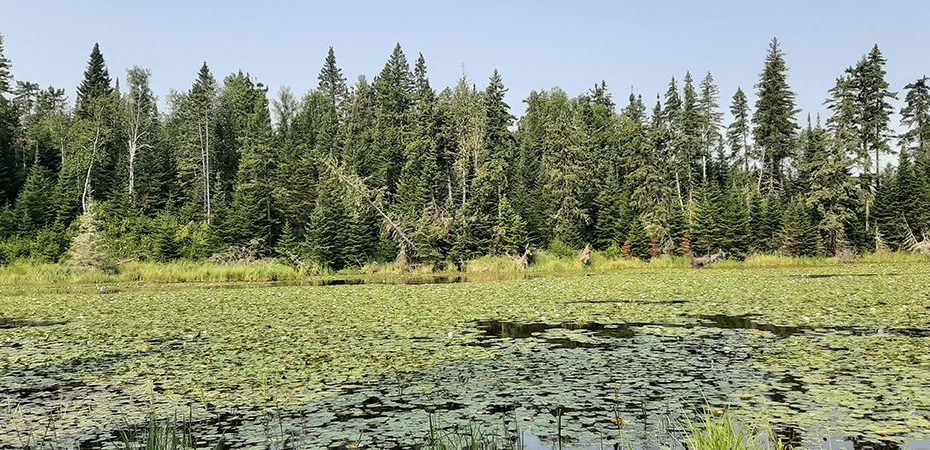As public concern over the climate and biodiversity crises grows, so too does public demand for more environmentally friendly products. Often products that companies claim to be environmentally friendly come about through voluntary certification systems that allow producers to add a logo showcasing sustainable practices. In a sea of sustainability claims and logos, it’s important to ask what the various certification systems require in practice.
To help you understand forestry certifications, we’re highlighting some key differences between two logos you’ve likely seen on various wood and paper products sold in Ontario – “FSC” (Forest Stewardship Council) and “SFI” (Sustainable Forestry Initiative).
Background
Both FSC and SFI are voluntary certification systems that encourage sustainable forest management practices through their own standards, which have specific social, environmental and economic requirements.
Wabigoon Forest (FSC), Nabish Wetlands © Corina Brdar
FSC was started in 1994 by a group of environmental organizations, and is now an international system used in 93 countries. FSC Canada’s membership-based organization is built around four chambers: environmental, social, economic and Indigenous. Ontario Nature has been a long-standing member of the environmental chamber. SFI was also founded in 1994, by the American Forest & Paper Association. It’s a domestic system across Canada and the United States with a governance system determined by board leadership.
Multiple forestry companies across Ontario hold either FSC or SFI certifications, some hold both, and some do not hold any voluntary certifications. Once a forest has been certified, third-party auditors monitor compliance with the respective standards through annual audits. These annual audits are in addition to provincially mandated audits for all companies practicing industrial forestry on public land to ensure companies comply with provincial forestry regulations.
Requirements
At a high level, FSC and SFI’s standards share many overlapping themes and language – striving to recognize and respect Indigenous rights, and preserve areas of high conservation value, including areas of ecological, cultural or spiritual significance.
However, where SFI’s standard requirements are vague and more generalized, FSC’s standard requirements are more detailed and often include measurable indicators for auditors to assess a forestry company’s efforts against.
Cushing Lake (FSC) © Kristen Setala
Protecting environmental values:
Both standards outline that companies shall protect areas of high environmental value, but only the FSC standard describes exactly how a company should be doing this – detailing steps for identifying and setting aside a minimum of 10% of the forests they manage from industrial logging. Meanwhile the SFI standard requires no minimum amount of protection for such values and only requires a program for protecting environmental values, with no specific requirements or details on how to do so.
Endangered species:
The FSC standard requires companies operating within the range of boreal woodland caribou to go above and beyond provincial regulations and guidelines for this species. While the SFI standard has a requirement for a program for protecting endangered species, it does not require any species-specific programs nor details on what such a program should look like.
Indigenous rights:
Both FSC and SFI’s standards refer to the international principles set by the United Nations Declaration on the Rights of Indigenous Peoples, but only the FSC standard requires companies to adhere to the principle of Free, Prior and Informed Consent, and to meaningfully engage with Indigenous communities in culturally appropriate ways.
Scientific research:
Both FSC and SFI call for the use of the best available knowledge and science, but SFI takes it a step further by including a section for investing into forestry research, science, and technology. SFI also incorporates financial or in-kind support for research and knowledge transfer initiatives to build cooperation and address local issues of relevance (e.g., climate adaptation, water quality, ecosystem services or other biodiversity topics). But SFI’s standard does not require companies to invest a specified amount.
Boreal caribou bull © KILands.org
The Big Picture
While voluntary certification systems can be hugely beneficial, why do such certification systems even need to exist in the first place? The rules and processes for forest management set by the province’s laws and policies should ensure forests are managed sustainably and in ways that respect Indigenous rights. Whether the province and industry are living up to this is debatable.
Regardless of certification system, Ontario Nature will continue our efforts advocating for environmentally sound forestry practices that uphold Indigenous rights across the province.
To learn more about Ontario Nature’s work, visit our webpages on sustainable forestry and protected places.
Resources
Authors
Ontario Nature Protected Places Coordinator. Ontario Nature Brittney started as a volunteer with Ontario Nature in 2018, working on the Ontario Reptile and Amphibian Atlas. She holds a B.Sc. in zoology from the University of Guelph and an M.Sc. in conservation biology from the University of Kent. Brittney has a strong interest in the human dimensions of conservation and believes conservation success is rooted in education, science and working collaboratively with community members.
Alexander joined Ontario Nature in July 2024, coming aboard as the Protected Places Intern to assist the organization in its work with the Forestry Stewardship Council. He completed his bachelor’s degree in political science at Wilfrid Laurier University in 2020, followed by his master’s degree in international public policy at the Balsillie School of International Affairs in 2021. Previously, his experience in editorial support and policy research has allowed him to work at the United Nations in New York City, as well as the Pan American Development Foundation in Washington, DC. Outside of work, Alexander enjoys cooking, reading, and writing.
The post Navigating the Forest – How Sustainable Forestry Certifications Compare appeared first on Ontario Nature.
